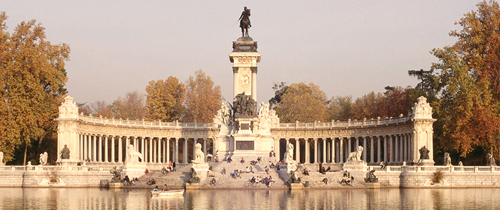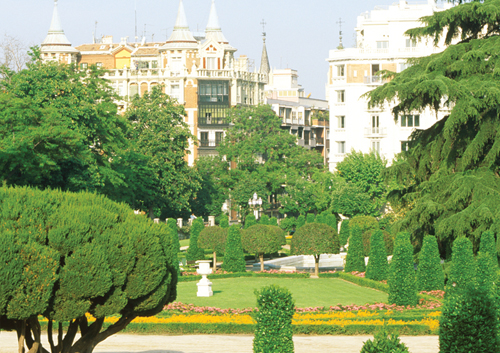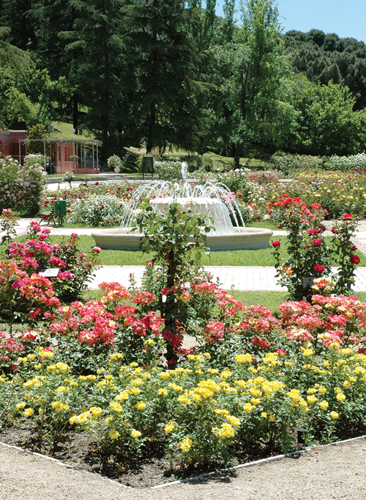Parque del Retiro In
1767, Carlos III broke with tradition by allowing members of the public
into the Retiro, providing they were “washed and suitably dressed”.
However it was not until the 1860s and the advent of the First Republic
that the partitions separating the royal enclosure from the public area
were finally torn down for good .

Parque del Retiro

Parque del Retiro
Jardín Botánico The
botanical garden is the perfect place to recharge the batteries after
the exhausting walk around the Prado Museum. The shady paths are lined
with statues, the air cooled by judiciously sited fountains . Jardines de Campo del Moro Surprisingly,
the gardens in the palace grounds were not laid out until the 19th
century. The name, “Moor’s field” refers to the Arab general, Ali Ben
Yusuf, who is said to have camped here while besieging the city after it
had fallen to the Christians. On a fine day, the views of the palace
and the Casa de Campo from here are unbeatable. Parque del Oeste This
lovely park, to the west of the city as its name suggests, was designed
in the early 20th century by Cecilio Rodríguez, head gardener at the
Retiro. Apart from the rosaleda
(rose garden), the main attraction is the Temple of Debod, an ancient
monument, dating from the 2nd century BC. It was a gift from the
Egyptian government. Cafés abound on Paseo del Pintor Rosales, a
terminus of the Teleférico.

Parque del Oueste
Casa de Campo The
city’s largest green space and Felipe II’s favourite hunting ground was
opened to the public with the overthrow of the monarchy in 1931.
Attractively planted with pines, oaks, poplars, and other trees, there
are also huge areas of open space, mostly scrub. The amenities include
cafés, picnic areas, restaurants, a boating lake, a zoo and the Parque de Atracciones amusement park. Parque Juan Carlos I This
attractive park lies within the exhibition grounds of the Campo de las
Naciones. Highlights include catamaran trips on the river and the
largest fountain in Spain, with 300 jets. Metro Campo de las Naciones Open 7am–1am Sun–Thu, 7am–3am Fri–Sat (summer), 7am–11pm Mon–Fri, 7am–midnight Sat–Sun (winter) Free Dis. access
Jardines de Sabatini These
small gardens next to the Palacio Real occupy the site of the royal
stables. Laid out in the 1930s, the design was based on original
18th-century plans. A quiet, restful place for a picnic . Parque de Berlín When
the Berlin Wall came down in 1989, everyone wanted a piece of the
action. Set among the fountains at the far end of this small
neighbourhood park, near the Auditorio Nacional,
are three concrete sections of the wall with original graffiti.
Children’s play areas and plenty of places to eat and drink are nearby. Príncipe de Vergara Metro Concha Espina Free Dis. access
Estación de Atocha The
space beneath the magnificent iron-and-glass canopy at Madrid’s central
railway station is occupied by a miniature botanical garden, replete
with palms and tropical plants .

Parque El Capricho These
delightful 18th-century gardens belonged to the palace of the Duke and
Duchess of Osuna and were landscaped by Jean Baptiste Mulot, the
gardener at Versailles, outside Paris. They have been restored to their
former glory with tree-lined paths, fountains, a lake and follies.
|